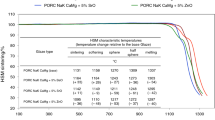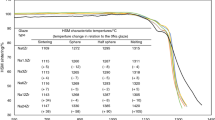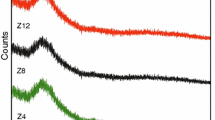Abstract
In this paper, the glass–ceramic materials from SiO2–Al2O3–Na2O–K2O–CaO system were examined. The zirconium oxide was added to this composition in three different amounts (1.5; 3; 6 mass%). In addition, the sample without zirconium oxide as the reference sample was prepared. To determine the effect of zirconium oxide on the thermal parameters, the characteristic temperatures, by using hot stage microscopy (HSM-Misura) and mechanical dilatometry (DL-Netsch), were measured. Based on these results, the viscosity curves were calculated (by the equation of Vogel–Fulcher–Tammann). Furthermore, for the description of the phenomena which occur during the heating–cooling cycle differential scanning calorimetry (DSC) was used. These data were linked with the results from X-ray diffraction and scanning electron microscopy with microanalyzer (EDS). Two crystalline phases in zirconium glazes were identified: zirconium oxide and zirconium silicate. The presence of crystalline phases (zirconium oxide, zirconium silicate) caused a nonlinear increase in the characteristic temperatures obtained by HSM. On DSC curves, the effect probably associated with crystallisation of zirconium silicate was registered. The addition of zirconium oxide to the tested glazes results in an increase in high-temperature viscosity, and the increasing ratio is proportional to the amount of zirconium oxide. The change in the value of this parameter is proportional to the amount of introduced zirconium oxide.








Similar content being viewed by others
References
Eppler RA, Eppler DR. Glazes and glass coatings. Westerville: The American Ceramic Society; 2000.
Shaw K. Ceramic glazes. Amsterdam: Elsevier; 1971.
Shackelford JF, Doremus RH. Ceramic and glass materials: structure, properties and processing. Berlin: Springer; 2008.
Ahmed M, Earl DA. Characterizing glaze-melting behaviour via HSM. Am Ceram Soc Bull. 2002;81(3):47–51.
Castilone RJ, Carty WM, Sriram D, Snyder RL. Crystallization of zircon in stoneware glazes. J Am Ceram Soc. 1999;82(10):2819–24.
Romero M, Rincon JM, Acosta A. Crystallization of a zirconium-based glaze for ceramic tile coatings. J Eur Ceram Soc. 2003;23(10):1629–35.
Atkinson I, Smith ME, Zaharescu M. Examining correlations between composition, structure and properties in zirco-containing raw glazes. Ceram Int. 2012;38(3):1827–33.
Balcerowiak W. DSC-Charakteryzowanie przemian fazowych. Zakopane: III Szkoła Analizy Termicznej; 2002.
Balcerowiak W. Różnicowa kalorymetria skaningowa. Zakopane: III Szkoła Analizy Termicznej; 2002.
Boudeghdegh K, Diella V, Bernasconi A, Roula A, Amirouche Y. Composition effects on the whiteness and physical-mechanical properties of traditional sanitary-ware glaze. J Eur Ceram Soc. 2015;35(13):3735–41.
Pasiut K, Partyka J. Wpływ tlenku cyrkonu na parametry powierzchniowe szkliw porcelanowych. Mater Ceram/Ceram Mater. 2016;68(3):246–53.
Gorodylova N, Dohnalova Z, Kostal P, Sulcova P, Vlcek M. Impact of particle size reduction on glaze-melting behaviour. J Therm Anal Calorim. 2014;116:605–12.
Hu A-M, Liang K-M, Wang G, Zhou F, Peng F. Effect of nucleating agents on the crystallization of Li2O–Al2O3–SiO2 system glass. J Therm Anal Calorim. 2004;78:991–7.
Wang S, Peng C, Huiyin X, Wu J. Microstructural evolution and crystallization mechanism of zircon from frit glaze. J Eur Ceram Soc. 2015;35(13):2671–8.
Amoros JL, Escardino A, Orts MJ, Moreno A. Zirconium glazes used in fast single fired wall tile manufacture I: crytallization mechanism. Br Ceram Trans. 1994;93:224–8.
Escardino A, Moreno A, Amoros JL, Orts MJ, Barba A. Zirconium glazes used in fast single fired wall tile manufacture. Br Ceram Trans. 2000;99:72–6.
McCoy M, Lee WE. Heuer AH Crystallization of MgO–Al2O3–SiO2–ZrO2 glasses. J Am Ceram Soc. 1986;69(3):292–6.
Pina-Zapardiel R, Esteban-Cubillo A, Bartolome JF, Pecharroman C, Moya JS. High wear resistance white ceramic glaze containing needle like zircon single crystals by the addition of sepiolite n-ZrO2. J Eur Ceram Soc. 2013;33(15–16):3379–85.
Szumera M. Charakterystyka wybranych metod termicznych cz. 2. LAB Lab Apar Bad. 2013;18(1):24–33.
Szumera M. Charakterystyka wybranych metod termicznych cz.1. LAB Lab Apar Bad. 2012;17(6):28–34.
Leśniak M, Gajek M, Partyka J, Sitarz M. Thermal characterization of raw aluminosilicate glazes in SiO2–Al2O3–CaO–K2O–Na2O–ZnO system with variable content of ZnO. J Therm Anal Calorim. 2017;128:1343–51.
Leśniak M, Gajek M, Partyka J, Sitarz M. Structure and thermal properties of the fritted glazes in SiO2–Al2O3–CaO–MgO–Na2O–K2O–ZnO system. J Therm Anal Calorim. 2017;. doi:10.1007/s10973-017-6183-x.
Wang S, Peng C, Huang Z, Zhou J, Lü M, Wu J. Clustering of zircon in raw glaze and its influence on optical properties of opaque glaze. J Eur Ceram Soc. 2014;34(2):541–7.
Gasek K, Partyka J, Gajek M, Panna W. Characteristic of synthesis and transformations of hardystonite in willemite glass-crystalline glaze based on thermal analysis. J Therm Anal Calorim. 2016;125(3):1135–42.
Partyka J, Gasek K, Pasiut K, Gajek M. Effect of addition of BaO on sintering of glass–ceramic materials from SiO2–Al2O2–Na2O–K2O–CaO/MgO system. J Therm Anal Calorim. 2016;126(3):1095–103.
Concepcion C, Oteo JL, Ocana E, Rubio J, Velasco MJ. The influence of ZrO2 particles on ceramic glazes used in the single-fired tile industry. Ceram Eng Sci Proc. 1997;18(2):96–113.
Acknowledgements
The work carried out has been financed by program PBS1/B5/17/2012.
Author information
Authors and Affiliations
Corresponding author
Rights and permissions
About this article
Cite this article
Pasiut, K., Partyka, J. The influence of ZrO2 addition on the thermal properties of glass–ceramic materials from SiO2–Al2O3–Na2O–K2O–CaO system. J Therm Anal Calorim 130, 343–350 (2017). https://doi.org/10.1007/s10973-017-6567-y
Received:
Accepted:
Published:
Issue Date:
DOI: https://doi.org/10.1007/s10973-017-6567-y




